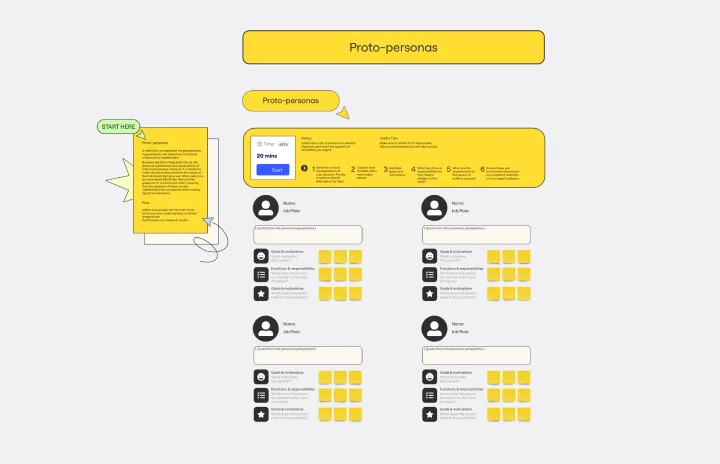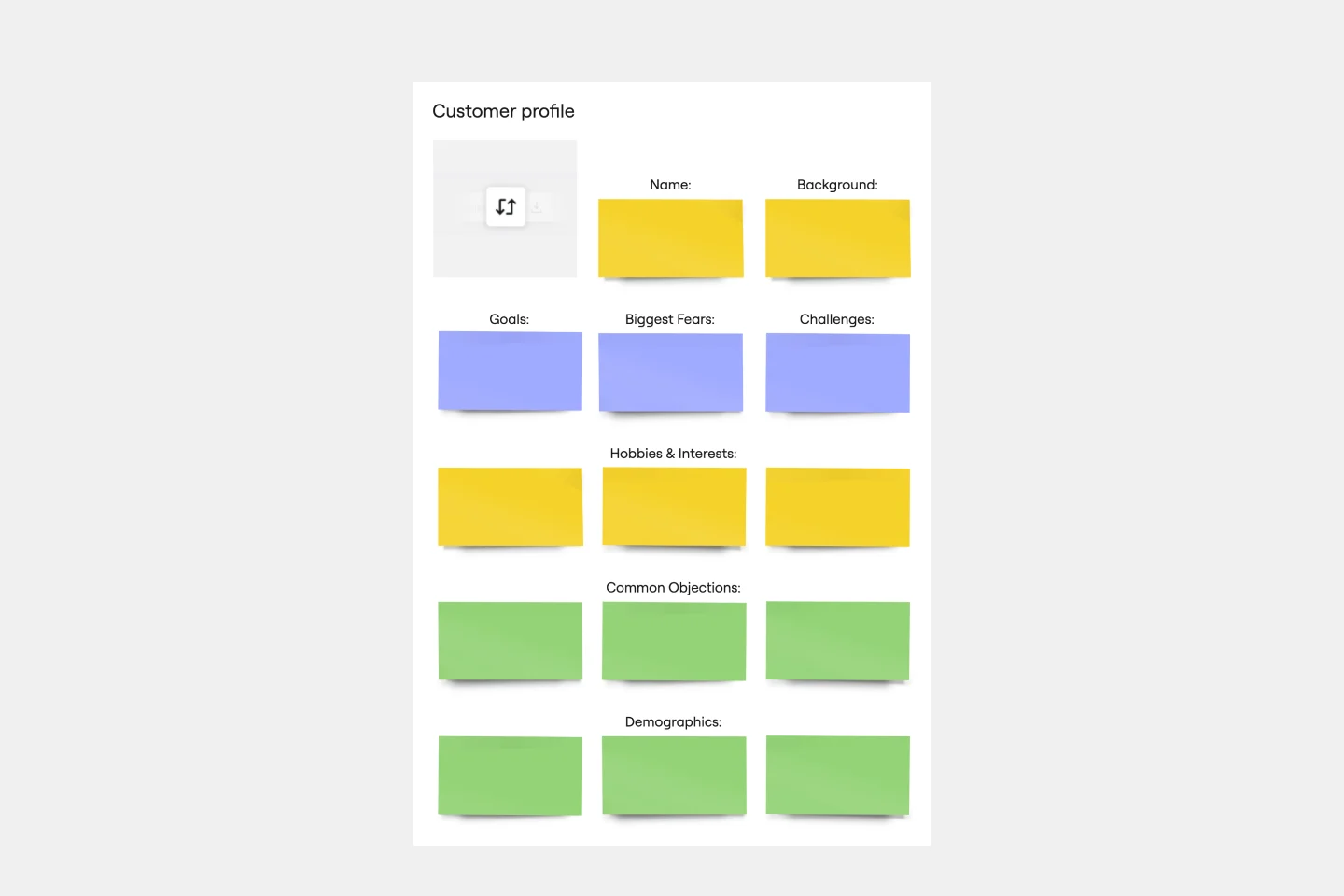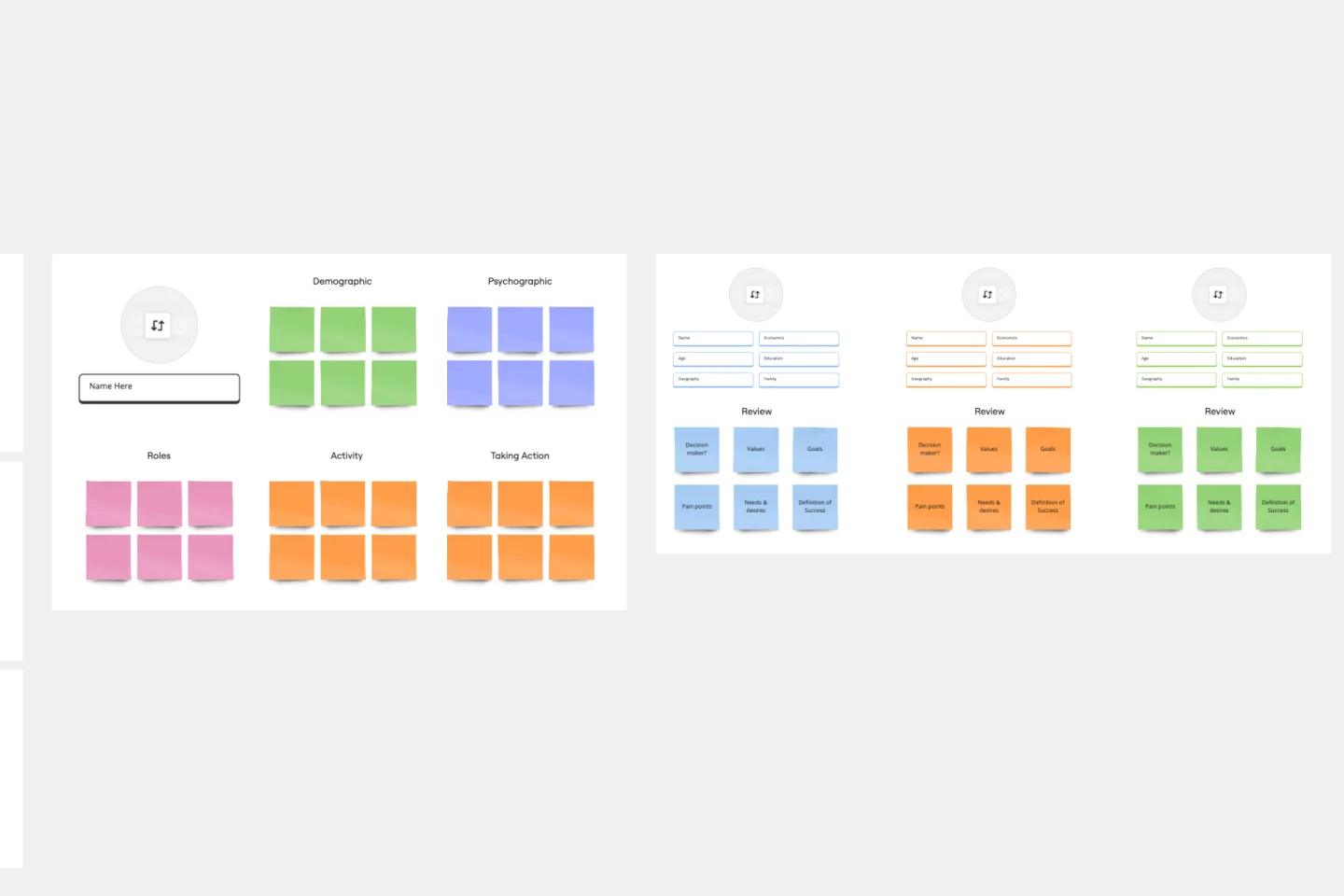About the Buyer Persona Template
The buyer persona template helps you better understand your customers. By identifying a fictional character who uses your product or service, you can develop a deep understanding of their needs and how you can serve them. It offers a user-centric approach when developing your product, marketing, and business strategies.
What is a buyer persona?
A buyer persona is the profile of your ideal customer. By filling in a buyer persona template, you can map out your key customer persona’s demographics, background, goals, challenges, and identifiers. As a result, your marketing campaigns are likely to be more effective.
Depending on the size of your business, you can have single or multiple personas. If personas are a new undertaking for your team, it’s okay to focus on crafting one detailed persona as a starting point.
Even though user personas give you a good overview of your customers, they are different from your target customers. Your target audience analyzes a large group of people. Personas are semi-fictional representations of your current and ideal customers.
Why do you need buyer persona templates?
Creating a buyer persona is a cornerstone of user-centered design. It’s a great way to evaluate the goals and vision of your product by better understanding who your customers are and what they want.
Let’s take a look at this — and some other benefits — in more detail:
Better understand buyer behavior. Creating a buyer persona helps you better understand how your customers behave and why they act in a certain way. You can get into the detail behind how they behave, which helps you understand them as people. As a result, you’re much better placed to effectively promote your product or service to them.
Tailor activity to the buyer’s needs. When you know who your customers are and what they’re looking for, you can tailor all your marketing and promotional efforts accordingly. Without knowing what your customers want, you won’t be able to target them in the same way.
Visualize the customer journey. Understand how your customers move through the customer journey with a buyer persona. From entering the top of the sales funnel through to the conversion, you’ll be able to see how and why customers move from one stage to the next.
Give customers a better experience. Knowing who your customers are and how they behave means you can offer them a unique experience. We know that customers value a tailored experience from brands, so you’ll be able to keep them happy while moving them through the customer journey.
When to use a buyer persona template
A buyer persona template helps your team to reach cross-functional alignment. Everyone can contribute and bring their unique angle when creating a buyer persona profile.
Personas guide the decision-making process of many teams, including:
Product developers who need buyer personas when building product roadmaps. Find and prioritize changes to products and services based on customer needs.
Marketers who need buyer personas to build useful strategies. Focus keyword research efforts and use personas as a reference when drafting copy. Personas also help narrow down and prioritize promotional initiatives.
Sales teams need buyer personas to build rapport with customers. Better prepare and empathize with customer challenges during sales-related interactions.
Customer support specialists who need buyer personas to better serve customers. Identify patterns in customer and product pain points to proactively problem-solve and empathize when a customer is frustrated, or the product doesn’t work as expected.
The most useful buyer personas reflect market research and insights gathered from user research – for instance, surveys, interviews, diary studies, A/B testing, and more. They can help your team empathize with customers and better meet your customer needs.
How to fill the buyer persona template
Making a user persona is easy. Get started by selecting this buyer persona template, then take the following steps to customize it to your needs.
1. Background and demographics
What do you know about your customers’ backgrounds, demographics, and identifiers? Ideally, you will base this data on the information you and your team have collected through a combination of interviews, surveys, and phone conversations. All of this information will give you insight into who your customers are.
You can also review who your competitors are targeting to get an idea of the type of customers you should be trying to reach.
2. Identifiers
Identifiers are elements that make this buyer behave or feel a certain way. For example, are they analytical or more practical? Energetic or calm? It essentially involves picking out the main personality traits of your customers. Recognizing these identifiers helps you understand how your customers behave and why.
3. Goals and challenges
Identifying a customer’s goals and challenges helps your team shape its product or service offering to successfully meet the needs of your customers. Let’s use an example to demonstrate.
Imagine you work at a recruitment agency. One of the key challenges your customers face is that they struggle to find top talent. Their goal is to retain new hires. By understanding these challenges and goals, you can make sure that your recruitment service addresses them directly.
4. What we can do
This stage is about identifying how your product or service can meet the needs of your buyers. Start by thinking about how your product or service can help buyers overcome their challenges.
How exactly can your product solve your customers’ problems? What’s new about your product that can change your buyer persona’s life? Answering these questions will make sure that you’re offering your buyers something they need.
5. Common objections
Common objections are the reasons why potential customers haven’t bought from you. What are the problems they have with your product? Are your competitors offering something better? Add these criticisms to your user persona template to visualize how you can overcome these objections. By tackling these objections head-on, you can put things right sooner rather than later.
6. Real quotes
When talking to customers in real-time, these insights can help product development, anticipate customer concerns, and iterate your product as needed. So make sure you source and include actual quotes from your customers. These could be comments on social media, online reviews, or even emails and telephone conversations with customers.
7. Marketing messaging
Your team needs guidance on talking to customers about company products and services, from specific details about products to a broader elevator pitch. During this stage, you can outline how your marketing messaging will be portrayed and how to craft relevant messages for your persona.
8. The elevator pitch
The final step is where you craft your product story. You’ll address the benefits of your product, what it does, and how it helps your buyer persona.
We do X, so you Y can do Z.
Tips for using your buyer persona template
Your buyers persona template is finished. So what happens next?
Here are some tips to help you use your customer personas and integrate them with your day-to-day work.
View your personas as real people. To see a cultural shift in your company, start viewing personas as real people affected by your decisions. They may be semi-fictional representations, but it’s helpful to treat them as though they’re real customers. Begin bringing them up in meetings, emails, and on calls as a reference point for customer motivations and pain points.
Iterate as the market or your business changes. A customer persona is a document for teams to consult whenever they need guidance on strategy and product development. It should be iterated when required as the market landscape changes.
Update your personas whenever you need to. Your customer personas are likely to change over time. For example, when customers want new things or move to a different life stage. As time progresses, you’ll need to revisit your personas and update them accordingly. With Miro, it’s easy to make these changes. Using the Buyer Persona Template, you can update your personas at any time, your changes will instantly appear to everyone who has access to the template.
Buyer Persona Template FAQs
Can I customize the template to include unique characteristics for my ideal customers?
Absolutely! The buyer persona template is fully customizable, allowing you to tailor it to reflect the unique characteristics and attributes of your ideal customers. We understand that every business is distinct, and that's why our template is designed to be flexible. You can add new fields, tweak existing ones, and even incorporate your own branding elements to make it truly yours.
How often should I update my buyer persona templates?
Updating your buyer personas should be an ongoing process. Markets evolve, and so do customer needs and behaviors. We recommend reviewing and updating your personas at least once a quarter. However, if you're in a fast-paced industry or you're just starting out and still collecting customer data, you might need to do this more frequently. Keeping your personas fresh ensures that your strategies remain relevant and effective.
Can I share my buyer persona template?
Yes, sharing your buyer persona template is not only possible—it's encouraged! Collaboration is key in crafting personas that truly represent your target audience. With Miro, you can easily share your template with team members and stakeholders. They can provide insights, offer feedback, and contribute to a well-rounded persona that everyone can use as a reference for creating targeted marketing campaigns, product development, and customer service strategies.

Miro
Your virtual workspace for innovation
Miro is an innovation workspace designed for teams of every size, everywhere, to dream, design, and build the future together. Our mission? To empower these teams to create the next big thing, powered by AI at every step of the way. Over 90 million users around the world rely on Miro to untangle complex ideas, put customer needs first, and deliver products and services faster. All supported by best-in-class security, compliance, and scalability.
Categories
Similar templates
Proto Persona Template

Proto Persona Template
Business decisions frequently rely on the personal preferences and assumptions of internal employees. However, making decisions that prioritize the needs of the individuals being served is helpful. When personas are developed effectively, they provide guidance to you and your team, ensuring that the interests of these crucial stakeholders are considered when making significant decisions.
Audience Persona Template

Audience Persona Template
The Audience Persona Template is an essential tool that helps gain valuable insights into the target demographic. It ensures that every strategic decision is tailored to meet the specific needs and preferences of the audience. The template is designed to cover areas like Background, Hobbies and Interests, Goals, Biggest Fears, Challenges, Common Objections, and Demographics. This detailed approach enables the creation of a nuanced and multi-dimensional audience profile. By understanding the basic demographic information and the target audience's deeper motivations, challenges, and apprehensions, teams can develop more empathetic, effective, and targeted strategies. This depth of understanding leads to more resonant and successful product developments, marketing campaigns, and customer engagement initiatives.
Target Audience Template

Target Audience Template
Understanding your target audience is vital to business success. How can you market yourself effectively if you don’t know who you’re targeting? Using the Target Audience template, you can review valuable data about who your customers are and what they want from your product or service.
Proto Persona Template

Proto Persona Template
Business decisions frequently rely on the personal preferences and assumptions of internal employees. However, making decisions that prioritize the needs of the individuals being served is helpful. When personas are developed effectively, they provide guidance to you and your team, ensuring that the interests of these crucial stakeholders are considered when making significant decisions.
Audience Persona Template

Audience Persona Template
The Audience Persona Template is an essential tool that helps gain valuable insights into the target demographic. It ensures that every strategic decision is tailored to meet the specific needs and preferences of the audience. The template is designed to cover areas like Background, Hobbies and Interests, Goals, Biggest Fears, Challenges, Common Objections, and Demographics. This detailed approach enables the creation of a nuanced and multi-dimensional audience profile. By understanding the basic demographic information and the target audience's deeper motivations, challenges, and apprehensions, teams can develop more empathetic, effective, and targeted strategies. This depth of understanding leads to more resonant and successful product developments, marketing campaigns, and customer engagement initiatives.
Target Audience Template

Target Audience Template
Understanding your target audience is vital to business success. How can you market yourself effectively if you don’t know who you’re targeting? Using the Target Audience template, you can review valuable data about who your customers are and what they want from your product or service.